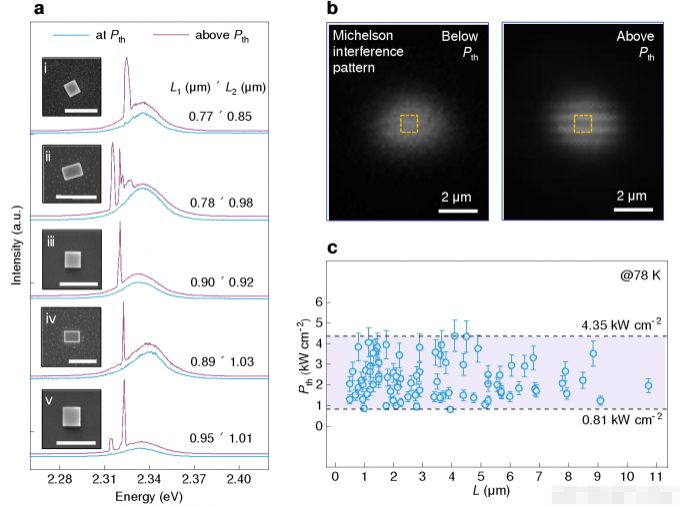Peking University realized a perovskite continuous laser source smaller than 1 square micron
It is important to construct a continuous laser source with a device area less than 1μm2 to meet the low energy consumption requirement of on-chip optical interconnection (<10 fJ bit-1). However, as the device size decreases, optical and material losses increase significantly, so achieving sub-micron device size and continuous optical pumping of laser sources is extremely challenging. In recent years, halide perovskite materials have received extensive attention in the field of continuous optically pumped lasers due to their high optical gain and unique exciton polariton properties. The device area of perovskite continuous laser sources reported so far is still greater than 10μm2, and submicron laser sources all require pulsed light with higher pump energy density to stimulate.
In response to this challenge, the research group of Zhang Qing from the School of Materials Science and Engineering of Peking University successfully prepared high-quality perovskite submicron single crystal materials to achieve continuous optical pumping laser sources with a device area as low as 0.65μm2. At the same time, the photon is revealed. The mechanism of exciton polariton in submicron continuous optically pumped lasing process is deeply understood, which provides a new idea for the development of small size low threshold semiconductor lasers. The results of the study, titled “Continuous Wave Pumped Perovskite Lasers with Device Area Below 1 μm2,” were recently published in Advanced Materials.
In this work, the inorganic perovskite CsPbBr3 single crystal micron sheet was prepared on sapphire substrate by chemical vapor deposition. It was observed that the strong coupling of perovskite excitons with the sound wall microcavity photons at room temperature resulted in the formation of excitonic polariton. Through a series of evidences, such as linear to nonlinear emission intensity, narrow line width, emission polarization transformation and spatial coherence transformation at threshold, the continuous optically pumped fluorescence lase of sub-micron-sized CsPbBr3 single crystal is confirmed, and the device area is as low as 0.65μm2. At the same time, it was found that the threshold of the submicron laser source is comparable to that of the large-size laser source, and can even be lower (Figure 1).

Figure 1. Continuous optically pumped submicron CsPbBr3 laser light source
Further, this work explores both experimentally and theoretically, and reveals the mechanism of exciton-polarized excitons in the realization of submicron continuous laser sources. The enhanced photon-exciton coupling in submicron perovskites results in a significant increase in the group refractive index to about 80, which substantially increases the mode gain to compensate for the mode loss. This also results in a perovskite submicron laser source with a higher effective microcavity quality factor and a narrower emission linewidth (Figure 2). The mechanism also provides new insights into the development of small-size, low-threshold lasers based on other semiconductor materials.
Figure 2. Mechanism of sub-micron laser source using excitonic polarizons
Song Jiepeng, a 2020 Zhibo student from the School of Materials Science and Engineering of Peking University, is the first author of the paper, and Peking University is the first unit of the paper. Zhang Qing and Xiong Qihua, professor of Physics at Tsinghua University, are the corresponding authors. The work was supported by the National Natural Science Foundation of China and the Beijing Science Foundation for Outstanding Young People.
Post time: Sep-12-2023







